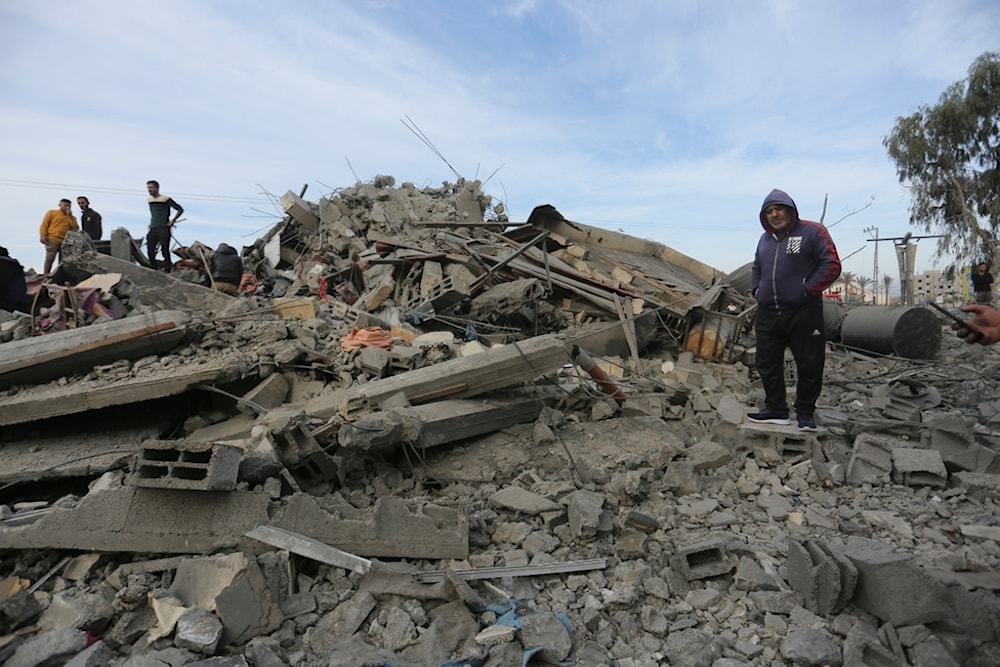Following stifling blockade, El-Sisi said 12Kt of aid to enter Gaza
According to Egypt's Foreign Ministry, "Israeli obstacles", such as truck inspection processes, were slowing the timely delivery of supplies to the Gaza Strip via the Rafah border crossing.
-

Palestinians look at destruction by the Israeli bombardment of the Gaza Strip in Rafah on Wednesday, Nov. 22, 2023 (AP Photo/Hatem Ali)
Egyptian President Abdel Fattah El-Sisi claimed Thursday that nearly 12,000 tonnes of humanitarian aid have been sent to Gaza via the Rafah crossing.
During what the Egyptian authorities described as a "solidarity with Palestine" conference in Cairo, El-Sisi expressed that the Rafah checkpoint will remain open "for humanitarian reasons to receive the sick and wounded and for medical care, food, and fuel to come there" detailing that close to 12,000 tonnes of aid have crossed.
According to Egypt's Foreign Ministry, "Israeli obstacles", such as truck inspection processes, were slowing the timely delivery of supplies to the Gaza Strip via the Rafah border between Egypt and besieged Gaza.
A ministry spokesperson stated on October 28, that "the trucks must be inspected at the Israeli Nitzana crossing before they head to the Rafah crossing on a journey that takes a distance of 100 km (62 miles) before they actually enter the Rafah crossing, which causes obstacles that significantly delay the arrival of aid."
Since "Israel" imposed a blockade on Gaza, the Rafah gate, which is administered by Egypt but does not border "Israel", has become the major point of humanitarian distribution.
Before the fighting, roughly 500 trucks per day crossed into Gaza, but in the first days of the war, just 12 trucks per day entered, according to UN Secretary-General Antonio Guterres.
According to a border source, that journey caused a 16-hour delay and is the reason why the number of trucks never again reached the high of 20 trucks on the first day deliveries resumed.
Israelis continue to stifle aid passage through Rafah crossing
During the Israeli aggression on Gaza, Egypt had limited aid passage to the strip, as there were no Israeli guarantees that the aid convoys would not be bombed, and Israelis imposed conditions on aid passage such as forced searches and dictating numbers of trucks.
Despite all diplomatic efforts being funneled to allow for a humanitarian corridor to transport aid into the besieged Strip, the Israeli warplanes continue to carry out aggressive and periodical raids against the Palestinian side of Rafah where the crossing is situated.
Since the beginning of the Israeli aggression, "Israel" had targeted the main road from the Egyptian border over to southern Gaza making it very difficult and even sometimes impossible for trucks to drive through it.
Palestinians had to conduct quick fixes allowing for the road to be drivable but there was no way to eliminate the risk of the road getting bombed again or the convoys getting targeted beyond a few guarantees that "Israel" was never known to necessarily keep.
The Israeli occupation has failed to honor international rules of war and has targeted places of worship, hospitals, UNRWA locations, and various schools where displaced Palestinians, most of whom were children, were taking refuge.
Cairo is facing increased pressure from the Israelis and Western countries to allow Palestinians to flee into Egypt, to fulfill Israeli goals of ethnic cleansing, while Palestinian President Mahmoud Abbas warned Blinken on Friday that the forced displacement of the Gazans would lead to a "second Nakba".
A humanitarian pause?
The Gaza Strip's humanitarian pause is set to commence on November 24 at 7 am local time (05:00 am GMT), as announced by the Qatari Foreign Ministry, noting that the Palestinian resistance is scheduled to release the first captives at 04:00 pm on the same day.
The ministry stated that a total of 13 Israeli women and children will be released on the initial day of the humanitarian pause in exchange for a number of Palestinian women and children.
Hamas has also confirmed that the humanitarian truce in the Gaza Strip is scheduled to commence on November 24 at 07:00 a.m. local time (05:00 a.m. GMT).
According to ON broadcaster on Thursday, Egypt has received a list of persons who would be freed during the ceasefire between "Israel" and Hamas, quoting Egyptian State Information Service Chairman Diaa Rashwan.
The agreement reached through Qatari and Egyptian mediation efforts was scheduled to go into effect on Thursday.
Truce does not mean peace
It is worth reminding that what is being implemented is a truce - not a permanent ceasefire.
The difference between a truce and a humanitarian pause is that a humanitarian pause, according to the UN Office for the Coordination of Humanitarian Affairs (OCHA), is defined as a "temporary cessation of hostilities purely for humanitarian purposes" and requires "the agreement of all relevant parties," stressing that typically it is implemented for "a defined period and specific geographic area."
Therefore, it is highly likely that fighting is set to resume once the truce expires.
In an exclusive interview with Al Mayadeen on Wednesday, Iranian Foreign Minister Hossein Amir-Abdollahian said that if the cessation of hostilities does not continue, the circumstances in the region would change, and the war's scope would widen.
"We do not look forward to its expansion, but any possibility is on the table if the aggression continues."
No release of IOF captives until all Palestinian prisoners freed: PIJ
On Thursday, the Palestinian Islamic Jihad movement (PIJ) stated that it will not release IOF captives until all Palestinian prisoners held in Israeli prisons are freed.
"We reiterate our position that enemy [Israeli] non-civilian captives will not be released until all of our prisoners are released from enemy prisons," the movement said in a statement.

 5 Min Read
5 Min Read








